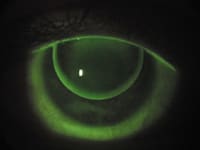GP insights
We Have
(Edge) Liftoff
BY JOHN MARK JACKSON, OD, MS, FAAO
Every contact lens clinician aims for a perfect GP fit every time. Although fitting GP contact lenses these days is mostly straightforward, understanding how parameter changes can affect the fit will increase your odds for success. Here's what I mean:
|
|
|
|
Figure 1. Thin peripheral pooling and low position indicates that this lens has too little edge lift. |
|

|
|
|
Figure 2. A wide peripheral pattern and high position indicates that this lens has too much edge lift. |
It's All About Lens Positioning
An often under-appreciated factor in GP lens performance is the effect of axial edge lift on lens movement and positioning. Standard GP lenses have either spherical or aspheric peripheral curves that result in a lens periphery that's flatter than the base curve/optic zone. This design allows for adequate tear exchange and smooth lens movement across the corneal surface as the patient blinks. The amount of edge lift is an indication of how flat the periphery is compared to the base curve, and knowing how much edge lift a lens has can help you "tweak" the fit.
The amount of edge lift in the contact lens greatly influences lens positioning. As a rule, the more edge lift a lens has, the more it will interact with the upper lid. A contact lens with too little edge lift will tend to poorly lid-attach and ride low, while a contact lens with excessive edge lift will tend to interact too much with the lid and ride high. Finding the right amount of edge lift for your patient can make the difference between fitting success and fitting disaster.
Determining Correct Edge Lift
Fortunately, it's not necessary to perform intensive calculations to determine the right amount of edge lift. You can gauge the effectiveness of the edge lift in a lens by observing the peripheral fluorescein pattern and positioning of the lens. Figures 1 and 2 show two lenses that are identical except that the edge lift in Figure 1 is 0.07mm and in Figure 2 it's 0.16mm. If the peripheral pooling is thin and/or the lens drops too quickly from the lid (Figure 1), then have the lab increase the amount of edge lift; conversely, if the lens shows a wide peripheral pattern and/or it lid-attaches too well (Figure 2), then have the lab decrease the edge lift. As a rule, have the lab change the edge lift in 0.03mm steps for a significant change.
If you're using a fitting set that features known peripheral curve parameters, then just tell the lab the parameters and how much change in edge lift you'd like. If you're using your lab's lens design, then the technicians should be able to tell you the amount of edge lift or you can simply tell them how to alter the lens (more or less edge lift). Most standard lens designs have about 0.10mm to 0.13mm of edge lift.
With GP lens fitting, success is in the details. Although your trial lens set's peripheral curve design will probably work fine most of the time, it's important to know how to improve the lens design and take your GP fitting to the next level.
Dr. Jackson is an assistant professor at Southern College of Optometry where he works in the Advanced Contact Lens Service, teaches courses in contact lenses and performs clinical research.




